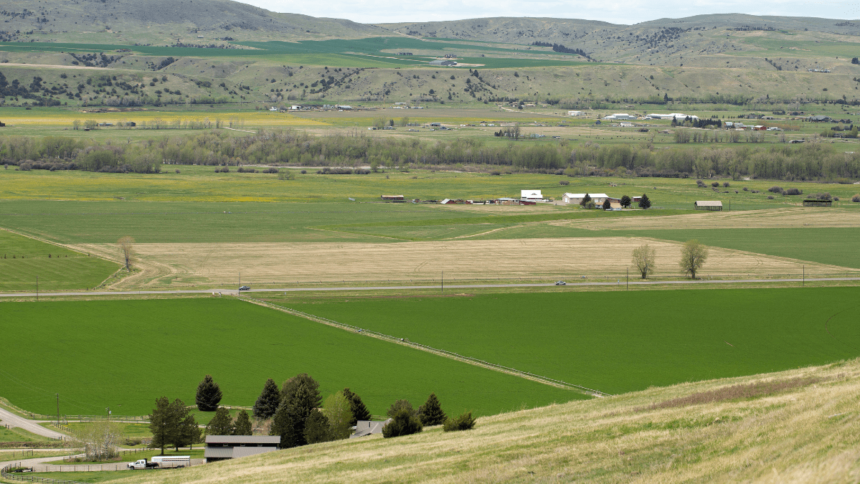Doug Rand is a fortunate man.
The 84-year-old Gallatin Gateway resident is a former assistant professor at Montana State University and resides in a home he conceived and constructed himself over more than 50 years.
Rand’s residence, a fairytale-like creation with intricate metalwork, various interconnected split levels, a whimsical ship’s pilothouse, and a functional bathtub on top of a lookout tower, is a collection of salvaged and repurposed materials unraveling like distinct chapters in his life.
“When little kids visit, they really enjoy it because there are small ladders, balconies, and other things,” Rand mentioned.
Rand’s luck endured when he survived a severe car accident in 1998. It could be argued that his luck rebounded when a woman he barely knew dropped everything and flew to Bozeman to care for him after the incident, eventually becoming his wife.

Given enough inquiries, Rand will eventually reveal that his 10-acre piece of land just off U.S. Highway 191 with panoramic views of the Spanish Peaks and the Bridger Range was bartered in a deal with a local farmer.
Indeed, Rand asserts he traded it fairly for architectural design work, back when the fields surrounding the highway were utilized to cultivate seed potatoes and the land possessed a fraction of the value it holds today.
However, after nearly a lifetime of expanding his fairytale property, it seems Rand’s fortune has run out.
That’s because his neighbors — a ranching family known as the Blacks with decades of residency — are prepared to lease the land to a mining company that plans to excavate a 130-acre gravel pit adjacent to his property. The scheme entails extracting and crushing over six million cubic yards of material over two decades in exchange for millions of dollars that would benefit the Blacks, a step they view as essential to sustain the family ranch.
Advocates argue that the gravel is urgently needed to finish road and construction projects in Gallatin County and Big Sky, a resort community approximately 40 miles further south on this meandering highway. Critics argue it’s merely another instance of affluent developers circumventing laws to construct vacation homes near Yellowstone.
Rand asserts there’s no way he could sell the custom home. It’s simply not feasible, he stated, particularly with a gravel mining operation stirring up dust on his doorstep.
“It won’t be sellable,” Rand mentioned, “and it won’t be healthy to stay here.”

Belgrade-based TMC Inc. is poised to manage the pit, but the company’s management has not initiated construction yet due to summer traffic congestion and an impending legal battle over the permit’s legality.
The dispute is not new. Land use disputes have been unfolding in Montana for decades, and the issue of the Black’s gravel pit has been in the headlines for over a year.
In March, the Montana Department of Environmental Quality endorsed the project’s final permit, prompting some last-ditch efforts from community members who are endeavoring to halt the project.
Tracie Gibbons serves as the president of the Gateway Conservation Alliance and resides in the nearby Hawk Hill neighborhood, where almost every residence has vistas of snow-capped mountains, verdant river bottoms, and what could potentially be a 130-acre gravel pit operational Monday through Friday for the next two decades.
The gravel road bending towards her neighborhood is delineated by a sizable plywood sign with an arrow pointing across the highway that reads “Stop This Pit.” A smaller sign states “No Trespassing. Private Roads.”
Gibbons and a few dozen of her neighbors established their nonprofit last summer upon discovering the proposed mine. Their endeavors have led to a series of public meetings, community fundraisers, and two legal challenges aimed at thwarting the project.

Members also garnered signatures and unsuccessfully petitioned Gallatin County to establish a 2,200-acre zoning district to prevent future gravel pits in the area.
“It’s distressing to witness people who’ve diligently saved throughout their lives only to purchase their dream residence and end up just 20 feet from a gravel pit they won’t be able to reside next to,” Gibbons said.
Gibbons informed Montana Free Press that her organization has raised over $68,000 to allocate toward legal fees to combat the pit, with some supporters discreetly paying the organization’s legal expenses that have exceeded that amount. Contributors to the GCA include small local businesses and prominent outdoor brands like Patagonia, Sitka hunting gear, and Ted Turner’s namesake foundation.
Moreover, Gibbons stated the GCA proposed to guide the Black family through the process of legally transferring the property to a conservation land trust that could have generated millions of dollars and safeguarded the land indefinitely, all without breaking ground.
“It’s hard to watch people who’ve saved their entire lives and then bought their dream home only to be 20 feet off of a gravel pit that they’re not going to be able to live next to.”
Tracie Gibbons, Gateway Conservation Alliance
“We had donors prepared to hand over a substantial sum to prevent that gravel pit from being established because they are passionate environmentalists, specifically regarding the elk migration,” Gibbons mentioned.
The offer proved fruitless, prompting Gibbons and the GCA to resort to the courts for what could evolve into a protracted and costly legal battle.
Gibbons mentioned her organization believes the Montana DEQ failed to adequately investigate the potential for pollution from the mine to seep into the nearby Gallatin River before authorizing the permit. She stated the DEQ also neglected to make environmental review documents available for public commentary during the permitting process, a contention the GCA’s legal advisors insist is illegal.
“Ultimately, the [Montana] Supreme Court will make the decision,” Gibbons stated.
House Bill 599, passed in 2021 by the Montana Legislature, complicates the entire situation. Helena attorney Kim Wilson elucidated that it aimed to streamline much of the bureaucracy surrounding gravel mine permits.
Wilson’s firm, Morrison, Sherwood, Wilson, and Deola, is representing the Gateway Conservation Alliance in two distinct lawsuits contesting the permit for the gravel pit. He expressed that the issue boils down to state politics and substantial capital invested in development.
“The Legislature, whether intentionally or unintentionally, knowingly or unknowingly, has essentially made it nearly impossible for neighbors of gravel mines to have any substantial involvement prior to a decision, and has essentially made it nearly impossible, unless you have significant funds, to challenge one of these establishments,” Wilson stated.
Characterizing the legal maneuvering his firm confronts as a “procedural quagmire,” Wilson added that he does not anticipate arguing the cases in court anytime soon. He prognosticated that the timeline would be drawn out over years rather than months.
However, he mentioned a successful legal challenge would promptly halt the pit’s operations, cautioning that developers would be wise to hedge their bets or face the risk of losing the funds expended on developing the gravel mine.
“Even if it commences and your court ruling is two years down the line, if that ruling overturns the permit, then it’s game over for the gravel mine,” Wilson remarked.
So, in the interim, does the pit proceed?

Not this year, according to Ken Stoeber, the general manager for TMC Inc., who relayed that the project’s legal complications, coupled with a busy summer road construction season, have halted mining, at least until the spring of 2025.
Stoeber indicated that TMC acknowledges the concerns of the neighbors and will implement industrial water sprayers to reduce dust, construct berms to obstruct views, and position its rock crusher as far away from residences as feasible to diminish noise levels. Most of these measures are voluntary and not mandated by state law.
Regarding polluting the nearby Gallatin River, Stoeber affirmed that excavating gravel and sand should not impact the waterway.
“We don’t utilize any chemicals for mining,” Stoeber stated. “We’re not mining into the water.”
On the other hand, for 43-year-old Bayard Black, who migrated from Minnesota to oversee the ranch for his father battling cancer in 2015, the uncertainty encompassing the project and its prolonged legal confrontations are beginning to test his patience.
Black, who could be found clearing birch trees or irrigating his pasture on one day and then engaging in web design or photography projects the next, is not your typical Montana rancher.
Black was summoned back to the state several years ago to assist his father with managing cattle when he learned of the elder Black’s health challenges. He mentioned that the decision to relocate his graphic design business back home and take on the role he was born into was a straightforward one.

Similar to his ancestors who nurtured the land before Montana even obtained statehood, Black believes his family must be financially independent, rebuffing the notion of placing the property under a conservation easement. To Black, such an arrangement would be akin to accepting unearned funds and, in his opinion, would bestow excessive power to state and local authorities.
“We’ve never accepted government funding in all our years,” Black asserted. “My father and my grandfather were proud of it.”
Instead, Black articulated that he will leverage the 130 acres earmarked for the gravel pit as an investment to infuse much-needed cash into his family’s more valuable property, a parcel encompassing about 2,300 acres that adjoins the national forest near the entrance of Gallatin Canyon. It is with this prime property that Black aspires to perpetuate his family’s heritage.
“A tractor costs more than a mortgage,” Black noted. “If we’re ever going to invest in the necessary infrastructure improvements this ranch needs, we need the pit.”
Black stated the payout from the gravel pit is projected to exceed $15 million over two decades. However, his family stands to reap substantially more if they opt against the battle, he indicated.
“I’ll sell to the highest bidder in Big Sky,” Black mentioned, adding, “If they zone me, I’m gone.”
While attending the local community meetings hosted by the Gateway Conservation Alliance and conversing with disgruntled neighbors, Black mentioned he believes they simply do not want to witness a substantial, unsightly excavation near what most would perceive as luxurious homes.
“A tractor costs more than a mortgage. If we’re ever going to invest in the necessary infrastructure improvements this ranch needs, we need the pit.”
ranch owner Bayard Black
“These are all people who live on gravel roads and drive on a highway,” said Black, alleging that opponents of the pit have disguised their repulsion for the mine with that of environmental concern, a sentiment he deems disingenuous and self-serving.
“I have empathy for my neighbors,” Black stated. “I have zero empathy for their tactics.”
Asked if he’s prepared for a protracted legal battle and years of court skirmishes with the Gateway Conservation Alliance, Black retorted: “If that’s their approach, I’d say ‘Be prepared.’ This isn’t my first rodeo, and I don’t want to see this happen to anyone, including my children.”
For Doug Rand, who mentioned he has started to perceive the threat to his home like a terminal illness, the enduring uncertainty is the most challenging aspect. At 84 years old, he ponders if he’ll be compelled to vacate his home. He also contemplates what has befallen the community he relocated to over 50 years ago. Politics and money, he expressed, have altered everything.
“A person shouldn’t be willing to do something just because it’s not illegal,” Rand remarked. “You know, there has to be more than laws, and there has to be a good-neighbor golden rule: Do unto others.”

In-depth, independent reporting on the stories impacting your community from reporters who know your town.
The post Tale of a changing West appeared first on Montana Free Press.





